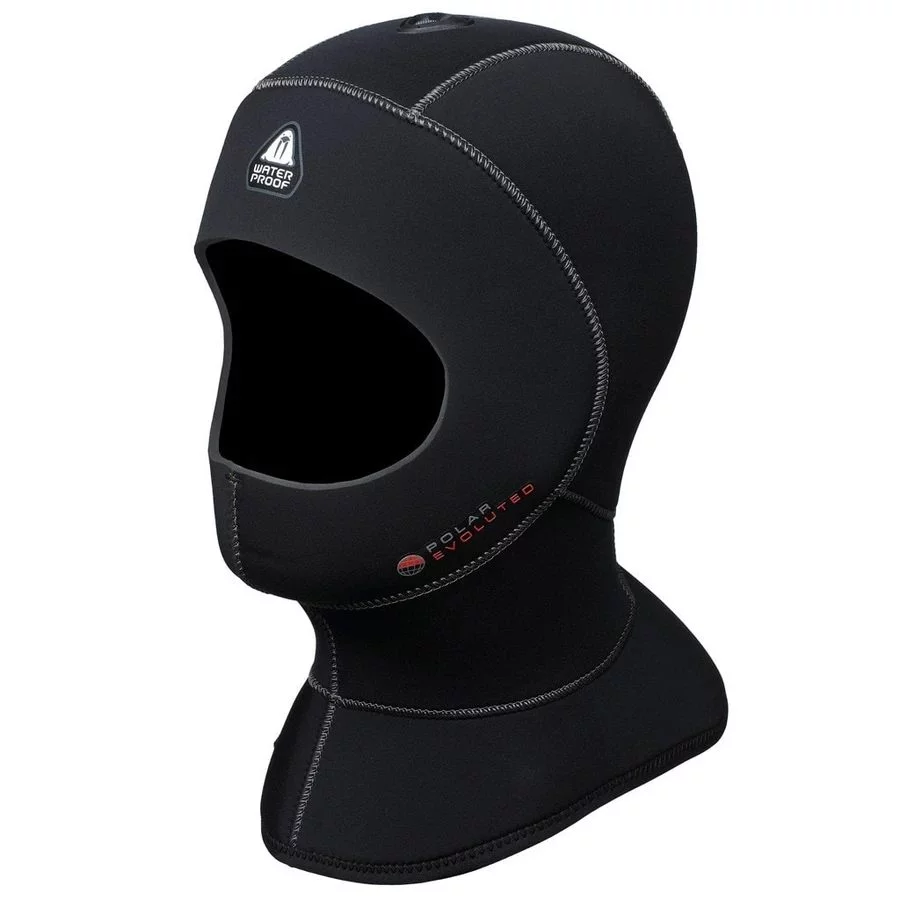A good wetsuit is like a Swiss Army knife; it’s a trusty old pal that’ll never let you down. And, just like a Swiss Army knife, not all wetsuits are created equal. It is essential to understand what divides the good from the bad when it comes to wetsuit construction, as well as to know what to prioritise for your own personal needs. With the help of our buyers advice guide and product recommendations, you should be able to find your best wetsuit for diving.
Best Wetsuits For Diving Reviewed
#1 – Fourth Element Proteus II 3/5mm
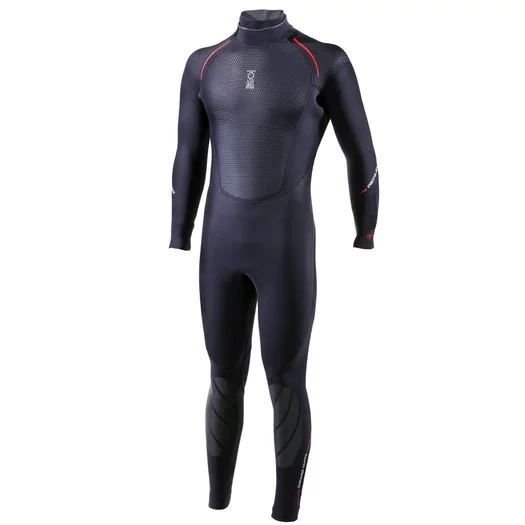
The Fourth Element Proteus II is a wetsuit utilising the highest quality of design technology. This is a wetsuit that keeps water ingress to the absolute minimum whilst ensuring maximum flexibility. This makes it the perfect wetsuit for those who want the most freedom of movement without compromising warmth.
Features:
- Blind-stitched, double-glued and taped watertight seams
- Watertight ‘Hydrolock’ inner neck seal
- Thermoflex lining provide comfort and added insulation
- ‘Hexcore’ lining to provide extra insulation where most needed
- Extremely flexible
- Internal ankle seals
- Glideskin wrist seals
- Ultra-stretch knee pads
#2 – Aqualung Bali 3mm
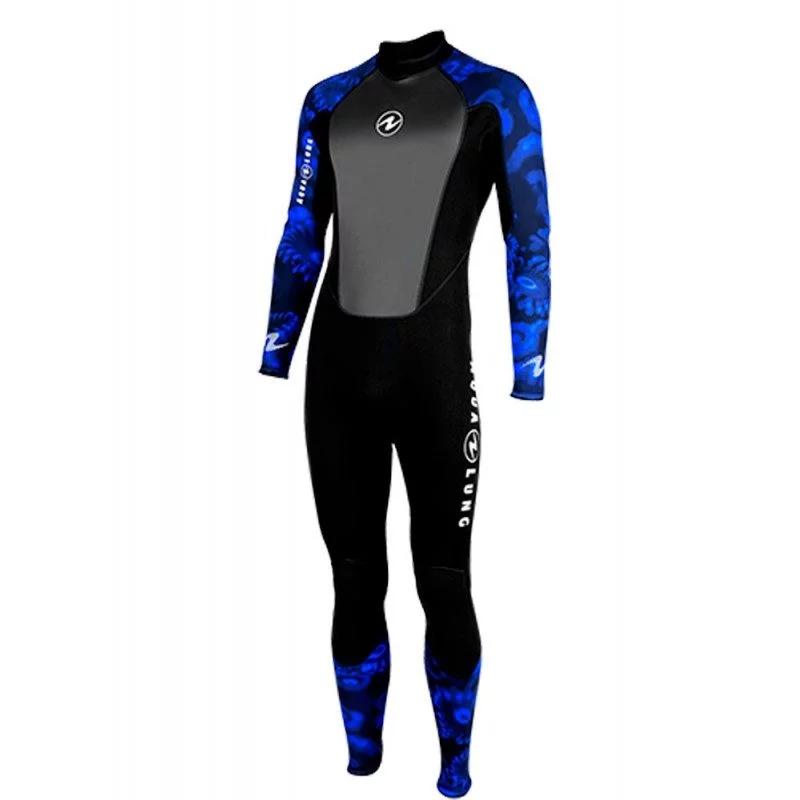
https://www.divestock.co.uk/aqua-lung-bali-3mm-wetsuit-camo-blue
Aqualung’s Bali suit offers a very light, travel-friendly tropical wetsuit with a unique coral print. At a very affordable price, this wetsuit is ideal for those wanting a wetsuit that affords the diver maximum flexibility and freedom of movement.
Features:
- Flatlock stitching
- Super-stretch neoprene on shoulders, sleeves and armpits
- Pre-bent anatomic legs and arms
- O-ring seals on sleeves to minimise water ingress
- Back zipper with flap cover
- Environmentally-friendly neoprene made without petroleum
#3 – Scubapro Nova Scotia Semi-Dry 7.5mm
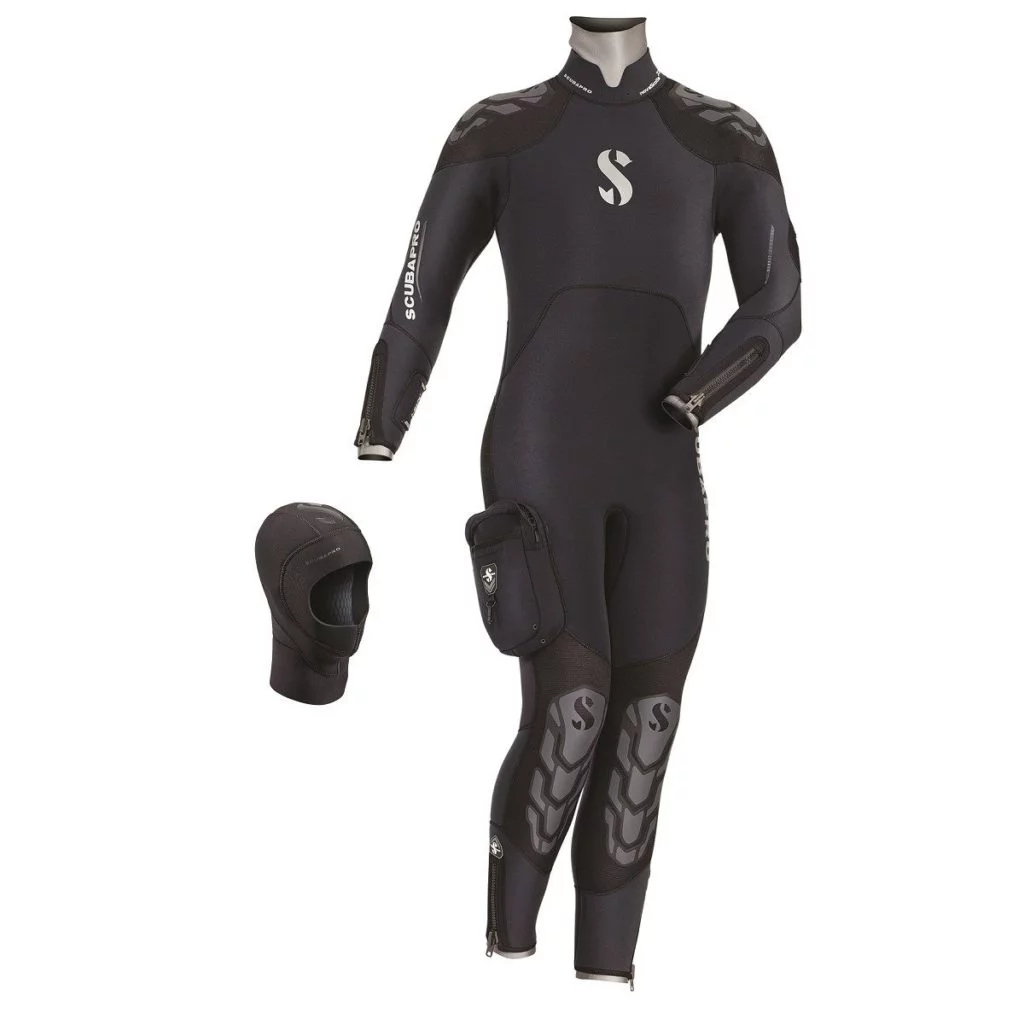
The Scubapro Nova Scotia 7.5mm Semi-dry suit is the ideal suit for those diving in cold temperatures who want to remain in a wetsuit. The suit is CE rated at Class A, meaning it is suitable for temperatures as low as 7° C. With blind-stitched seams and a waterproof YKK zipper, this is the perfect suit for those demanding the best wetsuit for diving.
Features:
- Blind-stitched seams
- YKK Aquaseal Vislon waterproof back zipper
- Interior lining to increase warmth and stretch
- Double-zipper system on wrist and ankle seals
- Fold under neck seal to minimise water ingress
- Shoulders and knee pads embossed with anti-abrasion pads
#4 – Waterproof SD Combat Series Semi-Dry 7mm
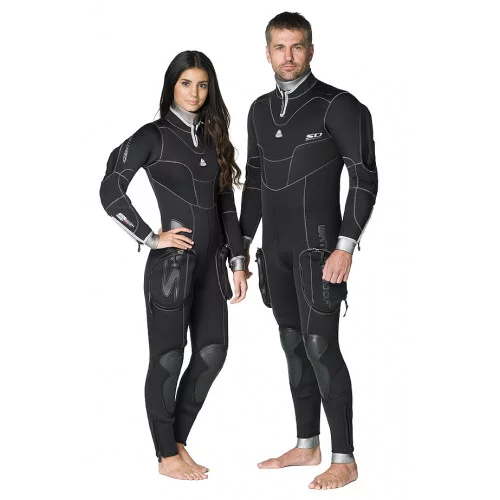
The Waterproof SD Combat Series Semi-dry suit is a suit made for the most demanding divers. It is originally a suit designed for and used by the Swiss Army, and is therefore a suit designed for any and all conditions.
Features:
- Anatomical sculpting
- Dry zipper
- Glideskin seals
- Reinforced shoulders
- ToughTex nylon coating on elbows and knees
- Microcell CR neoprene
#5 – Scubapro Thermal Tec 3/5mm
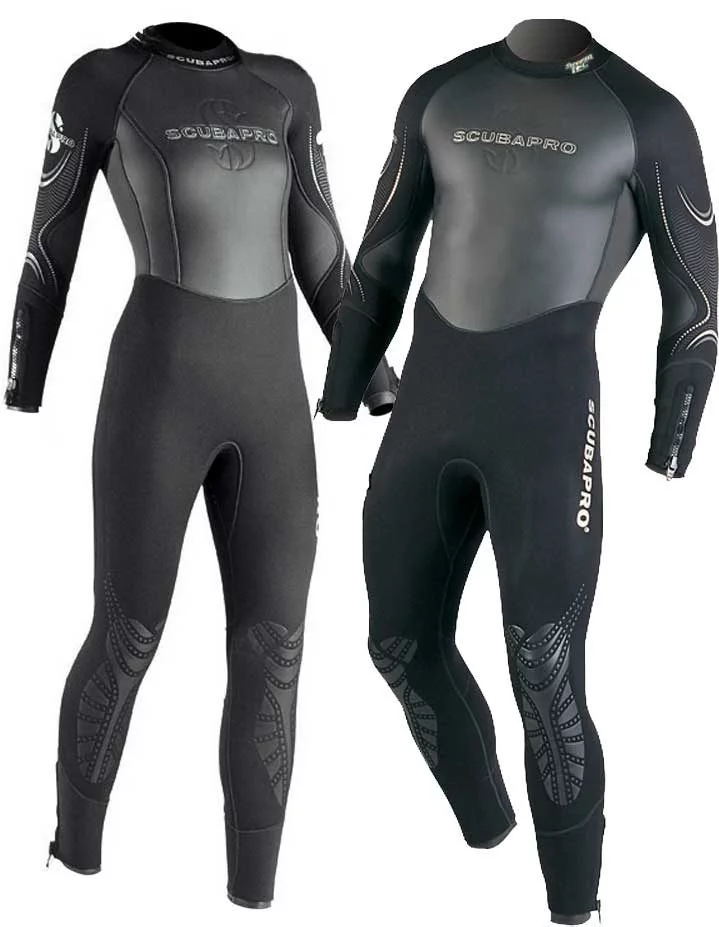
The Scubapro Thermal Tec is marketed as a ‘serious suit for serious divers.’ It’s well thought-out construction makes for a suit which provides insulation, comfort and durability, with no compromises.
Features:
- Fast drying neoprene
- Non-porous Fairskin fabric helps to prevent evaporative heat loss
- Heliospan material on torso for increased insulation
- Everflex stretch panels on high-stress areas for increased freedom of movement and flexibility
- Raw-cut collar for unprecedented comfort
- Wrist and ankle zippers facilitate donning and doffing as well as minimise water ingress
- Double blindstitched seams for maximum comfort and impermeability
Guide To Picking The Best Wetsuit For Diving
The Importance of Insulation
While someone’s resistance to the cold and its effect on certain body parts can make for a bit of rye banter (as long as you’re not the butt of the joke), the reality is that heat loss is a real threat that needs to be considered carefully. The body loses heat 25 times faster in water than in air, with some serious consequences. The end product of continuous heat loss is hypothermia, which can be life threatening. However, there are numerous problems to be encountered along the way to hypothermia, starting even when we are only slightly chilly.
The first consequences of excessive heat loss are a loss of dexterity and mental ability. The latter can have serious implications when it comes to decision making, especially when on complex/advanced dives involving deeper exposures, overhead penetration and/or decompression. Your own personal discomfort becomes a distraction.
On top of this, being cold is also reported to enhance narcosis. This turns into a vicious cycle, as narcosis leads to a disruption in thermoregulation, as your brain perceives your body to be warmer than it actually is, meaning that vasoconstriction will occur later than it should, thereby reducing the time it takes to become hypothermic.
Another serious consequence of the cold, especially for technical divers – though not limited to them – is to do with decompression efficiency. When we become cold, blood flow to our extremities is reduced in an effort to conserve heat. This is known as vasoconstriction (as already mentioned). In diving, maintaining a constant temperature is ideal, whether that is slightly higher or lower than average temperature. Problems occur when body temperature is changing throughout the dive. The reason for this is simple. If we begin our dive warm, our cells will be vasodilated, meaning that on-gassing will be happening across the body at a normal rate. If we then become progressively colder during decompression, our cells will vasoconstrict, resulting in less blood flow than normal. A reduction in blood flow will lead to a slower rate of off-gassing. The diagram below demonstrates this.
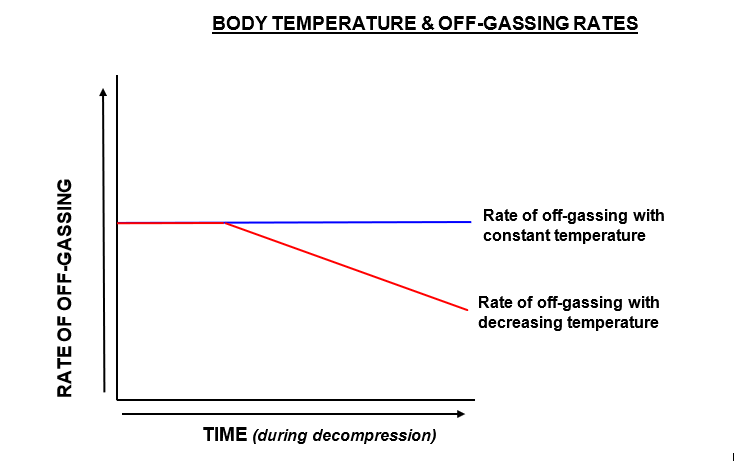
The problem is that our dive computer/decompression algorithm does not account for this reduction in the rate of off-gassing as it cannot measure the temperature of our body. Therefore, we will end the dive with a higher amount of dissolved inert gas than our computer assumes us to have. Obviously, in marginal cases, this increases the risk of decompression sickness. Becoming increasingly colder during a dive can have serious consequences beyond the threat of hypothermia.
Types of Exposure Suits
All exposure suits do the same job: slowing the body’s loss of heat. However, they do this at varying degrees of success dependent on the type of suit. As a broad overview, there are two primary types of exposure suit: wetsuits and drysuits.
Wetsuit
A wetsuit uses a very simple mechanism to insulate the body. It insulates the body by trapping a layer of water between the skin and the inner surface of the suit. This water is then heated by your body which, in combination with the neoprene itself, acts to stall the loss of bodily heat. The majority of neoprene wetsuits come in either 3mm, 5mm or 7mm density, with 3mm being the choice for tropical conditions and 7mm being for colder waters.
Drysuit
A drysuit, on the other hand, works in a very similar fashion, but traps a layer of air instead of water – hence the name. This air is then heated by the body which, in combination with thermal undergarments, stalls bodily heat loss – far more effectively than a wetsuit ever can. A drysuit is built from either neoprene or trilaminate material, and is effectively a dry bag for the body.
Semi-Dry Suit
Between a wetsuit and drysuit is something of a compromise; the semi-dry suit. The semi-dry suit takes technical aspects from both its siblings. It looks and fits like a normal wetsuit, but comes with a zipper and seals resembling those found in a drysuit. The zipper will be a fully ‘dry’ zipper, ensuring no water can permeate through it, and the seals will be a much tighter fit, resulting in less water exchange. With a standard wetsuit, the layer of trapped water is usually in constant exchange throughout the dive. This is because as we move the seals will open slightly to varying degrees, allowing new, colder water to ‘flush out’ the warmer trapped water. When this happens, overall bodily heat loss increases. The worse a wetsuit fits you, the more this will happen and, therefore, the quicker heat loss will occur. A semi-dry suit, however, exists to eliminate this problem of ‘flushing’, thereby insulating the diver better than a normal wetsuit can. It is a great option for those needing extra thermal protection but who do not want to put up with the hassle associated with drysuits, nor lose the feeling of freedom that a wetsuit affords.
Wetsuit Density
The density required in a wetsuit is arguably the most important factor in the selection process. This decision will be the result of numerous considerations, including but not limited to: water temperature, surface temperature and conditions, personal body mass, personal threshold for the cold, preferences regarding the need for flexibility, overall buoyancy characteristics, and the type of diving to be carried out. As a general rule of thumb, if you are unsure as to which density of wetsuit to get, or are stuck between two different densities, then it is advisable to go with the denser option. A wetsuit’s job is to keep you warm; there is little that is worse than a wetsuit which fails to do this.
Water temperature is the first and foremost deciding factor at play. As a very general guide, these are the recommended wetsuit densities for the corresponding temperature:
- 1-2mm or rash vest : 28° C+
- 3 mm: 24 – 28° C
- 5 mm: 20 – 24° C
- 7 mm/Semi-dry: 10 – 20° C
However, it must be emphasised that these are very general recommendations, and are largely dependent on a diver’s personal threshold for the cold. For example, I myself personally don’t like to dive in a wetsuit in temperatures less than 20° C, and instead switch to a drysuit. Similarly, I’m also much more comfortable in a 7mm for temperatures between 20-24° C. However, I know multiple divers who are very comfortable in a shorty wetsuit in 20° C water temperature, and others who have little problem diving in 10° C water with a 5mm. The latter divers I have in mind may have been Icelandic, yet – nevertheless – the point remains: tolerance to the cold varies from individual to individual.
Surface Temperature
A second consideration relating to temperature is that of the surface temperature. Although the water temperature may be considered warm, surface temperature and/or conditions may call for greater exposure protection, and vice versa. An example of this is in the Red Sea, particularly in Egypt. Water temperatures in the Red Sea tend to reach their perigee around 20-21° C in winter. This, according to the recommendations above, should call for exposure protection with a density of around 5mm. Yet, the widespread majority of diving instructors and perennial customer divers wear drysuits. Why, you may ask? The wind. Wind reaching speeds of up to 26 knots is very common for an Egyptian winter. This makes exiting the water and doffing your wetsuit, as well as donning your now damp wetsuit for a second or third dive, a very unpleasant experience. In my own experience of operating in the Red Sea in winter, many customers skip the second and/or third dives due simply to being too cold. Though on paper a place like Egypt with a water temperature minimum of 20-21° C may seem relatively warm, it is essential to research further into what the surface temperature and conditions are also like. In this respect, it is essential to talk with others who dive regularly, as well as throughout all the different seasons (depending on your own plans), in the particular place you are planning to use your wetsuit. Once you have surveyed the general opinion, it is then necessary for you to consider your own personal threshold to the cold despite what others may recommend.
Temperature Consistency
In a similar vein to this is the issue of temperature consistency. Although a brief google search may bequeath to you the knowledge that the Mediterannean has a peak temperature of 28° C and a low of 17° C, what it will not tell you is that these temperatures are not static. The issue of thermoclines is something to be considered when purchasing a wetsuit. A thermocline is ‘the transition layer between warmer mixed water at the ocean’s surface and cooler deep water below’ (NOAA). Simply, it is a point in the water column in which a sudden, drastic change of temperature is encountered. The Mediterannean is one example of many where thermoclines are common. Sometimes they are permanent; often they are sporadic. I myself have encountered balmy 26° C water turn suddenly to a menacing 15° C, simply upon descending from 17 metres to 18. And that was during a Spanish summer. Therefore, it is highly recommended to consult with others in the area you are planning to dive, in order to gauge the frequency and severity of thermoclines. The stats may say 28° C, but they won’t say anything about the 20° C lurking at 14m!
Type of Diving
Another consideration when it comes to selecting the correct wetsuit density is the type of diving that will be carried out with it. If you are considering technical and/or cave diving, in which long dive times in excess of two hours are commonplace, then you may be better off investing in a drysuit rather than looking for a very warm wetsuit with extra insulation accessories. If that is the case, then you may wish to read our article on choosing your first drysuit. Ultimately, a wetsuit can only provide you with so much insulation and warmth. No matter how many extra insulating layers you may use, it remains as the name says – wet! Clearly, there comes a point in which a drysuit makes more sense than a wetsuit combined with multiple insulating accessories. The point at which this is, however, is largely dependent on personal preference. On top of this, it is vital to remember that your wetsuit will gradually lose its thermal properties with repetitive use, and will thus be nowhere near as warm on the 200th dive compared to the first.
Weight
It is also worth taking into account the weight of your prospective wetsuit; both for issues regarding travelling as well as in-water buoyancy characteristics. In most cases, the denser the wetsuit, the heavier it will be. For the travelling diver, this is something to consider when purchasing a wetsuit. Similarly, the denser the wetsuit, the more positively buoyant it will be. For the majority of divers, this may not seem like an important consideration, and – admittedly – it is not a paramount issue when selecting a wetsuit. However, for divers who already use a lot of weight, this may pose itself to be an inconvenience, as even more weight will be required.
Flexibility and Freedom
One of the many reasons people prefer to dive with a wetsuit rather than a drysuit, is due to the flexibility and feeling of freedom that the former affords. The less dense the wetsuit is, the more flexible and free you will be. But equally, the less dense the wetsuit, the less thermal protection it will provide. Some companies, however, have balanced the issue of thermal protection and flexibility by producing wetsuits with varying densities based on body parts. For example, a wetsuit with 5mm around the midsection and 3mm around the arms and legs. This results in greater insulation of the core whilst allowing more flexibility in the arms. This is a great option for those who love the feeling of freedom that comes with a wetsuit, but want to retain its insulating properties.
Seams & Stitching
The way in which a wetsuit is stitched will contribute significantly towards its insulating capabilities. Stitching refers simply to the way in which the separate panels of neoprene are stitched together to make the whole wetsuit. There are three types of stitching most commonly used in wetsuit construction: overlock, flat and blind.
Overlock Stitching
Overlock stitching is both the simplest and least desirable type of stitching. With an overlock stitch, the ends of the two neoprene panels are rolled into one and then stitched together. This is done on the interior of the wetsuit. As one can imagine, this results in the seams protruding like tectonic plates in collision. This type of seam stitching results often in skin irritation and chafing for the diver. As well as this, the seam is very permeable, and thus allows substantial water ingress, contributing to increased flushing of the suit. The overlock stitching method is found most commonly in cheap suits used for tropical diving.
Flatlock Stitching
Flatlock stitching is akin to subducting tectonic plates. The two ends of the neoprene panels are laid over one another, and then the stitches run vertically through the neoprene. The benefit of this system is that it is far more flexible and strong than the overlock system, as well as being flat and streamlined. However, as the stitches run through the neoprene, numerous tiny holes are created, resulting in a very permeable seam. Therefore, flatlock stitching should only be used in wetsuits designed for tropical diving.
Blind Stitching
Blind stitching, on the other hand, forms the most flexible and least permeable seam. The ends of the neoprene panels are brought together to touch, and are then glued together. The seam is then stitched from the inside. However, the key difference lies in the fact that the stitching does not go all the way through to the other side of the seam. Due to this, the seam remains watertight. On wetsuits made for very cold conditions, double blind stitching is often used, in which the exterior of the seam is also stitched. Blindstitching is found on the highest quality suits.
Accessories
There are numerous options available to supplement the insulative properties of your wetsuit. These include: hoods, vests, hooded-vest, shorts, and socks. You may ask why you would want to invest in these extra products instead of simply buying a thicker wetsuit, or even a drysuit. The answer is that it is a matter of personal preference. Many people prefer to dive in a wetsuit, no matter how cold it gets, as they love the feeling of freedom and flexibility that comes with it, as well as the ease of maintenance compared to that of a drysuit. If that is the case for you, then read on.
Hooded Vest
A hooded-vest is simply, as the name describes, a sleeveless vest with an attached hood which is worn underneath your wetsuit. By having the hood connected to the vest, the neck seal is protected from water ingress, resulting in less flushing and greater insulation. This is an excellent addition to any wetsuit to increase the sealing mechanism and therefore overall insulation. Fourth Element is one example of a company which sells great quality exposure protection. They have a Thermocline product range, in which they sell hooded vests. These are particularly attractive as they are extremely light as well as being neutrally buoyant as they are made from recycled nylon from ‘ghost’ fishing nets, rather than neoprene.
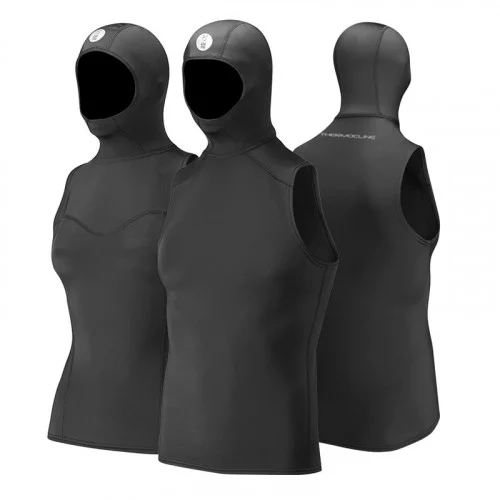
Undershorts
Similarly, a pair of undershorts for your wetsuit are also great in adding an extra layer of thermal protection. They are worn slightly higher than waist level, thereby increasing insulation around the core. Again, Fourth Element also offer an excellent pair of undershorts as part of their Thermocline range, as shown below.
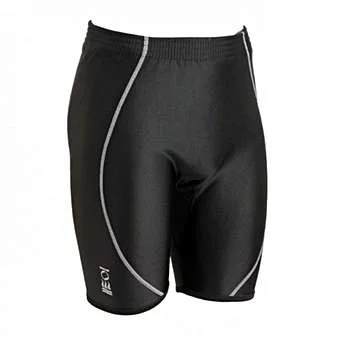
Hood
A hood is also a simple and extremely effective way to double up your thermal protection. Approximately 75% of bodily heat is lost through the head. Therefore, there is no excuse not to protect your own when diving. It is ideal to get a hood which is attached to a vest in order to minimise water ingress. However, if you only want a hood, then it is best to invest in one that runs all the way down the neck, not just around the head. Hoods come in varying densities just like wetsuits, and it is again a matter of a personal preference.
